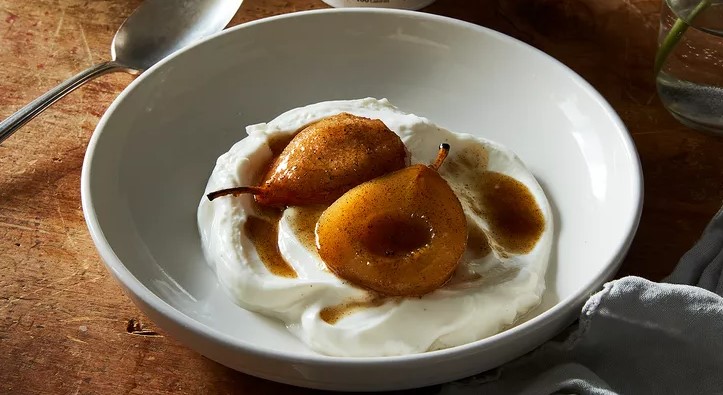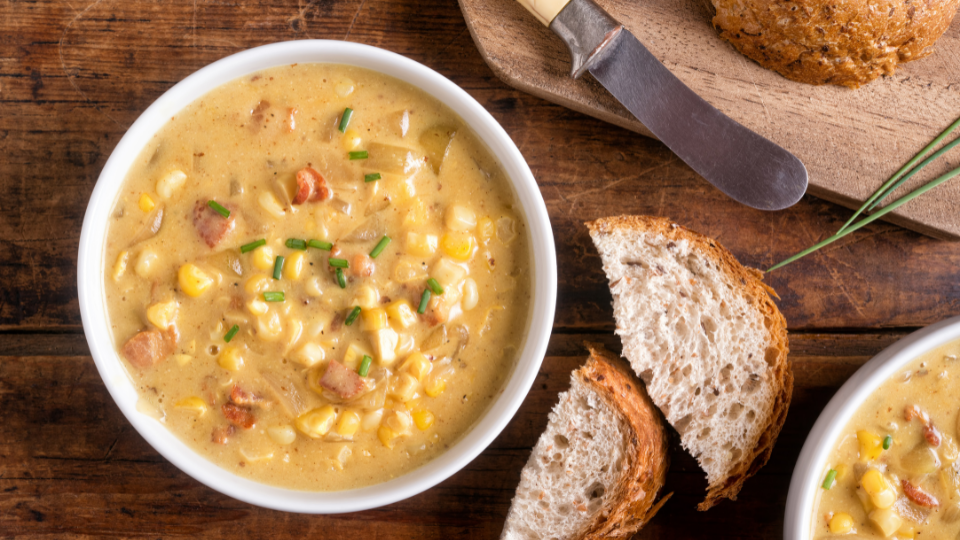Pumpkin Spice Lattes. Soup Season. Apples and honey. Gorgeous gourds. It’s fall, y’all, and we’re here to celebrate the seasonal autumn foods that boost your well-being. Keep reading to discover a nutritious three-course menu of easy fall recipes you can try at home, featuring seasonal Colorado ingredients.
Step 1: Gather materials
It’s time to break that slow-cooker out of storage and celebrate soup season. With the onset of cooler weather, soups and stews bring warmth and hearty meals with the ease of “set-it-and-forget-it” recipes.
WellPower’s president and CEO, Dr. Carl Clark, shares one of his favorite fall recipes, which highlights corn, potato, and a little heat from jalapeño. This easy soup serves as a great first course or can stand as a meal on its own when served with your favorite bread.
Course 1: Slow-Cooker Corn Chowder
Ingredients
- 4 ears of corn
- 1 pound small creamer potatoes, halved or quartered into 1-inch chunks
- 4 cups chicken broth or stock
- 2 (4-ounce) cans chopped mild green chiles
- 5 scallions, sliced, whites and green parts separated
- 5 garlic cloves, smashed and chopped
- 1 tablespoon unsalted butter
- 1 jalapeño, stemmed, seeded and minced
- 1 tablespoon yellow or white miso (optional)
- 1 teaspoon kosher salt, plus more as needed
- 1/2 cup sour cream
- 1/2 cup light or heavy cream or half-and-half
- Black pepper, to taste
- Chopped crisp, cooked bacon (optional), for serving
Directions
Cut the kernels from the corn cobs and put them in a bowl; refrigerate. Snap the cobs in half.
In a 6- to 8-quart slow cooker, combine the cobs, potatoes, broth, green chiles, scallion whites, garlic, butter, jalapeño, miso (if using) and salt. Cook on low until the potatoes are very tender, about 5 hours.
About 10 minutes before serving, use tongs to discard the cobs. Stir in the corn kernels and scallion greens and cook until warmed through. Turn off the slow cooker.
Whisk the sour cream and light or heavy cream together in a large liquid measure or a bowl. Slowly whisk a few ladlefuls of the hot broth into the cream mixture until combined. Stir the cream mixture into the chowder. Grind in a generous amount of black pepper. Taste for seasoning and add more salt and pepper if necessary. Serve in bowls, and top with bacon, if desired.
Step 2: Find seasonal produce
Have you ever noticed that sometimes the grocery store has the most perfect strawberries during one season, but then a few months later, they’re smaller, less juicy and kind of tasteless? Choosing in-season produce will often yield the best tasting, most nutritious fruits and vegetables your region has to offer.
In Colorado in the fall, some great options are: pears, apples, pumpkins, winter squash, rutabagas, turnips, parsnips and celery root.
Notice a theme? Root veggies, gourds and orchard fruits are all the rage this time of year, which is why you’ll see seasonal recipes featuring apples, pumpkins, and potatoes in autumn.
Durango, Colorado is home to our second course: a simple quiche that highlights squash as the star ingredient (and can be prepared while your corn chowder is cooking in the crock pot).

Course 2: Butternut squash, arugula and bacon quiche:
Ingredients:
- 1 pie crust
- 3 slices bacon, diced
- 2 cups chopped butternut squash
- 1 small white onion, chopped
- 1 clove garlic, minced
- 6 eggs, whisked
- 3/4 cup milk
- 3 Tbsp. flour
- 1/2 tsp. baking powder
- 1/2 tsp. salt
- 1/8 tsp. black pepper
- 3 handfuls fresh arugula, whole or roughly chopped
- 4 ounces crumbled gorgonzola, blue or feta cheese
Directions:
Preheat oven to 350ºF. Lay prepared pie crust in an ungreased pie plate. Bake for 5 minutes, then set aside.
Cook bacon in a large sauté pan over medium-high heat until crispy, stirring occasionally. Remove bacon with a slotted spoon, leaving grease in pan. Add butternut squash and onion and sauté for 8-10 minutes, or until the onions are translucent and the squash is tender. Add garlic and sauté for an additional minute. Remove from heat.
In a separate large bowl, whisk together eggs, flour, baking powder, milk, salt and black pepper. Stir in the sautéed vegetables, arugula, cheese and cooked bacon, and stir until well combined.
Transfer the quiche filling into crust and use a spoon to smooth the surface. Bake for 45-50 minutes, or until a toothpick inserted comes out clean. Quiche will rise while baking, but should settle back down once you remove it from the oven. Remove from the oven and allow the quiche to rest for at least 5 minutes. Slice and serve warm.
Step 3: Spice it up
From the Hatch vs Pueblo chiles debate to seasonal spice blends (looking at you, pumpkin spice everything), spices and spicy foods bring delicious heat to chilly weather.
Fall recipes that include ingredients like chiles or warming spices can be beneficial for your health (as well as clearing out your sinuses from those October sniffles).
We’ll let you in on another industry secret: the pumpkin spice blend doesn’t include any pumpkin. It’s a combination of warming spices characteristic of fall: cinnamon, ginger, nutmeg, allspice and cloves. This blend has roots from long before the PSL (Pumpkin Spice Latte), with written record dating back to 1798.
Highlighting both warming spices and seasonal fruit in Colorado, our final course is a sweet (and still moderately healthy) end to this autumnal meal.

Course 3: Apple Cider and Cardamom Roasted Pears
Ingredients:
- 1 pound small pears (about 6), seckle or fiorelle are perfect for this
- 1 tablespoon unsalted butter, softened
- 1/2 cup pear or apple cider
- 1 to 3 tablespoons maple syrup
- 1 tablespoon fresh lemon juice
- 1 teaspoon ground cardamom
- Seeds from one vanilla bean or 1 teaspoon vanilla bean paste
- 1 pinch salt
Directions:
Preheat oven to 375ºF and butter a baking dish with the tablespoon of butter.
Whisk the cider, maple syrup, lemon juice, cardamom, vanilla bean seeds and salt together in a measuring cup.
Peel the pears and slice them in half from top to tail. Use a paring knife to carefully remove the cores, but leave the stems attached for presentation if you like.
Arrange the pears cut sides down in the baking dish and pour the cider mixture over the top. Bake the pears, basting occasionally, until softened and the juices in the pan have reduced to a few tablespoons and have started to caramelize at the edges, 40-50 minutes depending on the size and ripeness of the pears.


